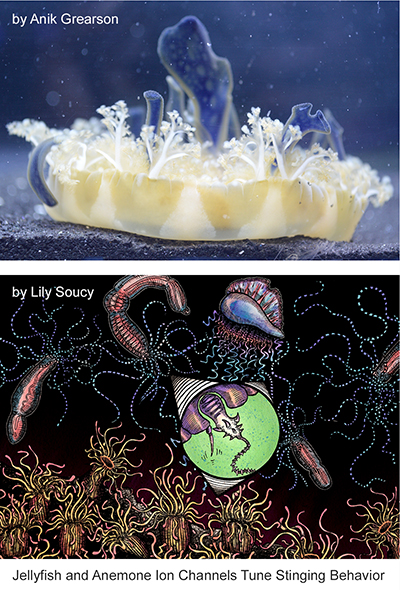Sea anemones are known for stinging, but not all anemones sting alike. By comparing two related anemones, the Bellono Lab has identified a small change in how a particular RNA is spliced that explains big differences in stinging behavior. A paper describing these results recently appeared in the journal eLife.
“Paying attention to single proteins while thinking about systems level neuroscience, I think, is very important,” says MCB faculty Nicholas Bellono.“And I hope that this study demonstrates how that’s important…This study shows, to me anyway, that studying single proteins and how single protein function facilitates adaptation can really give us insight into complex behavior.”
In a previous study led by then-graduate student Keiko Weir, the Bellono Lab investigated the stinging behavior of the sea anemone Nematostella, a predatory species that buries itself under sand and ambushes prey with its tentacles. Stinging allows Nematostella to paralyze its prey, but doing so is energetically costly. Every time the sting response goes off, stinging cells called nematocytes fire tiny toxin-covered barbs, which have to be regrown before the anemone can sting again.
Weir and her collaborators found that Nematostella responded to a combination of physical touch and chemicals from its prey species but did not respond to touch alone. They also identified a calcium ion channel as responsible for setting off the stinging barbs. In contrast to ion channels in neurons, they found that the calcium ion channels in Nematostella are usually inactivated, such that they cannot be stimulated unless the ion channel conformation changes. “It shuts off the system before it receives a stimulus, and that’s a really weird property for these ion channels to exhibit,” Bellono says.
The new study, led by Neuroscience graduate student Lily He , looks into stinging behavior in one of Nematostella’s relatives, an anemone called Exaiptasia. Exaiptasia dwells in open areas in shallow waters, where its photosynthetic symbionts can thrive, and primarily stings in self-defense. He and her colleagues wanted to understand the differences between predatory stinging in Nematostella and defensive stinging in Exaiptasia.
The team collaborated with biophysicist Agnese Seminara of the University of Genoa to model the costs and benefits of the two stinging strategies. They found that for a starving predatory anemone, there were big rewards for stinging, but the benefits of defensive stinging didn’t correlate with whether the anemone was hungry or not. The models also indicated that a defensive stinger would likely respond to physical touch alone. These predictions lined up with what He and her colleagues observed in the live anemones.
He teamed up with postdoctoral fellow Corey Allard to reveal that the same ion channel also set off Exaiptasia’s defensive stinging. “It’s very serendipitous,” says Bellono. “We analyzed these two different anemones with no idea of what would be different. Yeah, we had studied this calcium ion channel before, but we had no idea that would be the thing. Anemones sting in different ways, and just by observation, we were able to follow how this happens.”
Conducting these experiments on sensitive stinging cells was no easy feat. “Our major technique of choice for studying electrophysiology is called whole cell patch clamp,” Bellono explains. “How this works is we manipulate a glass pipette that’s hooked up to an amplifier to measure very small currents, and the glass pipette has to touch and actually manipulate the stinging cells. And that’s very difficult, because…the cells themselves are very explosive, as they shoot venom-covered barbs. So sometimes when we’re trying to work with the cell, they’ll shoot out the barb, and then your experiment is doomed. Figuring out how to work with the cells is really a challenge. Lily and Corey did a great job of sorting this out.”
After identifying the ion channel in Exaiptasia, the team carried out a series of structure and function experiments where they would induce subtle mutations in the ion channel and observe how those mutations changed the stinging behavior. These experiments revealed that Exaiptasia splices its ion-channel-encoding RNAs differently than Nematostella. This alternative splicing alters a single subunit in the ion channel protein complex, Exaiptasia’s ion channels differently from Nematostella’s.
“We were able to determine a specific region of one subunit of the calcium channel and found it’s tuned across these anemones with very different properties,” Bellono says. “We think it’s a great example of connecting subtle differences within even a part of a protein complex to different organismal behaviors.”

by Nick Bellono, Diana Crow and Lily He


